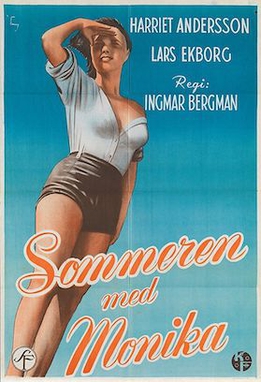A Summer with Monika (1953) is a Swedish film directed by Ingmar Bergman from a novel by Per Anders Fogelstrom.
Monika (Harriet Andersson), for a long time a believable character, and Harry (Lars Ekberg), not much explored, are two adolescent lovers. Both are inexperienced and foolish but also harassed and even mistreated. Eventually they marry, but in the film’s final third, unfortunately, Bergman allows Monika to become a surprising tramp. This is, nonetheless, one of the Swede’s few successful movies, remarkably made with its wonderful exterior shots, long takes and (of course) mise en scene.
In addition, it is a famously erotic film—and not just for 1953—albeit Andersson has assets other than those under her blouse. She is an actress so “natural” it is uncanny, as true in her hysteria as in everything else. She creates a good blending of sophistication and innocence, and is enticingly kinetic. It is a great performance in a more-than-okay movie.
(In Swedish with English subtitles)


